
- •Contents
- •Preface
- •Introduction to Computers, the Internet and the Web
- •1.3 Computer Organization
- •Languages
- •1.9 Java Class Libraries
- •1.12 The Internet and the World Wide Web
- •1.14 General Notes about Java and This Book
- •Sections
- •Introduction to Java Applications
- •2.4 Displaying Text in a Dialog Box
- •2.5 Another Java Application: Adding Integers
- •2.8 Decision Making: Equality and Relational Operators
- •Introduction to Java Applets
- •3.2 Sample Applets from the Java 2 Software Development Kit
- •3.3 A Simple Java Applet: Drawing a String
- •3.4 Two More Simple Applets: Drawing Strings and Lines
- •3.6 Viewing Applets in a Web Browser
- •3.7 Java Applet Internet and World Wide Web Resources
- •Repetition)
- •Class Attributes
- •5.8 Labeled break and continue Statements
- •5.9 Logical Operators
- •Methods
- •6.2 Program Modules in Java
- •6.7 Java API Packages
- •6.13 Example Using Recursion: The Fibonacci Series
- •6.16 Methods of Class JApplet
- •Class Operations
- •Arrays
- •7.6 Passing Arrays to Methods
- •7.8 Searching Arrays: Linear Search and Binary Search
- •Collaboration Among Objects
- •8.2 Implementing a Time Abstract Data Type with a Class
- •8.3 Class Scope
- •8.4 Controlling Access to Members
- •8.5 Creating Packages
- •8.7 Using Overloaded Constructors
- •8.9 Software Reusability
- •8.10 Final Instance Variables
- •Classes
- •8.16 Data Abstraction and Encapsulation
- •9.2 Superclasses and Subclasses
- •9.5 Constructors and Finalizers in Subclasses
- •Conversion
- •9.11 Type Fields and switch Statements
- •9.14 Abstract Superclasses and Concrete Classes
- •9.17 New Classes and Dynamic Binding
- •9.18 Case Study: Inheriting Interface and Implementation
- •9.19 Case Study: Creating and Using Interfaces
- •9.21 Notes on Inner Class Definitions
- •Strings and Characters
- •10.2 Fundamentals of Characters and Strings
- •10.21 Card Shuffling and Dealing Simulation
- •Handling
- •Graphics and Java2D
- •11.2 Graphics Contexts and Graphics Objects
- •11.5 Drawing Lines, Rectangles and Ovals
- •11.9 Java2D Shapes
- •12.12 Adapter Classes
- •Cases
- •13.3 Creating a Customized Subclass of JPanel
- •Applications
- •Controller
- •Exception Handling
- •14.6 Throwing an Exception
- •14.7 Catching an Exception
- •Multithreading
- •15.3 Thread States: Life Cycle of a Thread
- •15.4 Thread Priorities and Thread Scheduling
- •15.5 Thread Synchronization
- •15.9 Daemon Threads
- •Multithreading
- •Design Patterns
- •Files and Streams
- •16.2 Data Hierarchy
- •16.3 Files and Streams
- •Networking
- •17.2 Manipulating URIs
- •17.3 Reading a File on a Web Server
- •17.4 Establishing a Simple Server Using Stream Sockets
- •17.5 Establishing a Simple Client Using Stream Sockets
- •17.9 Security and the Network
- •18.2 Loading, Displaying and Scaling Images
- •18.3 Animating a Series of Images
- •18.5 Image Maps
- •18.6 Loading and Playing Audio Clips
- •18.7 Internet and World Wide Web Resources
- •Data Structures
- •19.4 Linked Lists
- •20.8 Bit Manipulation and the Bitwise Operators
- •Collections
- •21.8 Maps
- •21.9 Synchronization Wrappers
- •21.10 Unmodifiable Wrappers
- •22.2 Playing Media
- •22.3 Formatting and Saving Captured Media
- •22.5 Java Sound
- •22.8 Internet and World Wide Web Resources
- •Hexadecimal Numbers

Chapter 4 |
|
Control Structures: Part 1 |
183 |
|
|
|
|
|
|
Type |
Size in bits |
Values |
Standard |
|
|
|
|
|
|
boolean |
8 |
true or false |
|
|
char |
16 |
’\u0000’ to ’\uFFFF’ |
(ISO Unicode character set) |
|
|
|
(0 to 65535) |
|
|
byte |
8 |
–128 to +127 |
|
|
|
|
(–27 to 27 – 1) |
|
|
short |
16 |
–32,768 to +32,767 |
|
|
|
|
(–215 to 215 – 1) |
|
|
int |
32 |
–2,147,483,648 to +2,147,483,647 |
|
|
|
|
(–231 to 231 – 1) |
|
|
long |
64 |
–9,223,372,036,854,775,808 to |
|
|
|
|
+9,223,372,036,854,775,807 |
|
|
|
|
(–263 to 263 – 1) |
|
|
float |
32 |
Negative range: |
(IEEE 754 floating point) |
|
|
|
–3.4028234663852886E+38 to |
|
|
|
|
–1.40129846432481707e–45 |
|
|
|
|
Positive range: |
|
|
|
|
1.40129846432481707e–45 to |
|
|
|
|
3.4028234663852886E+38 |
|
|
double |
64 |
Negative range: |
(IEEE 754 floating point) |
|
|
|
–1.7976931348623157E+308 to |
|
|
|
|
–4.94065645841246544e–324 |
|
|
|
|
Positive range: |
|
|
4.94065645841246544e–324 to 1.7976931348623157E+308
Fig. 4.16 The Java primitive data types.
4.14 (Optional Case Study) Thinking About Objects: Identifying
Class Attributes
In “Thinking About Objects,” Section 3.8, we began the first phase of an object-oriented design (OOD) for our elevator simulator—identifying the classes needed to implement the simulator. We began by listing the nouns in the problem statement and then created a separate class for each category of noun and noun phrase that perform an important duty in the elevator simulation. We then represented the classes and their relationships in a UML class diagram (Fig. 3.23). Classes have attributes (data) and operations (behaviors). Class attributes are implemented in Java programs as variables; class behaviors are implemented as methods. In this section, we determine many of the class attributes needed to implement the elevator simulator. In Chapter 5, we examine how these attributes represent an object’s state, or condition. In Chapter 6, we determine class behavior. In Chapter 7, we concentrate on the interactions, often called collaborations, between the objects in the elevator simulator.
© Copyright 1992–2002 by Deitel & Associates, Inc. All Rights Reserved. 7/2/01
184 |
Control Structures: Part 1 |
Chapter 4 |
Consider the attributes of some real-world objects: A person’s attributes include height and weight, for example. A radio’s attributes include its station setting, its volume setting and whether it is set to AM or FM. A car’s attributes include its speedometer and odometer readings, the amount of gas in its tank, what gear it is in, etc. A personal computer’s attributes include its manufacturer (e.g., Sun, Apple, IBM or Compaq), type of screen (e.g., monochrome or color), main memory size (in megabytes), hard disk size (in gigabytes), etc.
We can identify the attributes of the classes in our system by looking for descriptive words and phrases in the problem statement. For each descriptive word or phrase we find, we create an attribute and assign that attribute to a class. We also create attributes to represent any additional data that a class may need (as the need for this data becomes clear throughout the design process).
We begin examining the problem statement looking for attributes distinct to each class. Figure 4.17 lists the words or phrases from the problem statement that describe each class. The sentence “The user can create any number of people in the simulation” implies that the model will introduce several Person objects during execution. We require an integer value representing the number of people in the simulation at any given time, because we may wish to track, or identify, the people in our model. As mentioned in Section 2.9, the ElevatorModel object acts as the “representative” for the model (even though the model consists of several classes) for interactions with other parts of the system (in this case, the user is a part of the system), so we assign the numberOfPeople attribute to class ElevatorModel.
Class Elevator contains several attributes. The phrases “is moving” and “is summoned” describe possible states of Elevator (we introduce states in the next “Thinking About Objects” section), so we include moving and summoned as boolean attributes. Elevator also arrives at a “destination floor,” so we include the attribute destinationFloor, representing the Floor at which the Elevator will arrive. Although the problem statement does not mention explicitly that the Elevator leaves from a current Floor, we may assume another attribute called currentFloor representing on which Floor the Elevator is resting. The problem statement specifies that “both the elevator and each floor have capacity for only one person,” so we include the capacity attribute for class Elevator (and class Floor) and set the value to 1. Lastly, the problem statement specifies that the elevator “takes five seconds to travel between floors,” so we introduce the travelTime attribute and set the value to 5.
Class Person contains several attributes. The user must be able to “create a unique person,” which implies that each Person object should have a unique identifier. We assign integer attribute ID to the Person object. The ID attribute helps to identify that Person object. In addition, the problem statement specifies that the Person can be “waiting on that floor to enter the elevator.” Therefore, “waiting” is a state that Person object may enter. Though not mentioned explicitly, if the Person is not waiting for the Elevator, the Person is moving to (or away from) the Elevator. We assign the boolean attribute moving to class Person. When this attribute is set to false, the Person is “waiting.” Lastly, the phrase “on that floor” implies that the Person occupies a floor. We cannot assign a Floor reference to class Person, because we are interested only in attributes. However, we want to include the location of the Person object in the model, so we include the currentFloor attribute, which may have a value of either 1 or 2.
© Copyright 1992–2002 by Deitel & Associates, Inc. All Rights Reserved. 7/2/01

Chapter 4 |
Control Structures: Part 1 |
185 |
Class Floor has a capacity attribute. The problem statement specified that the user could situate the person on either “the first or second floor”—therefore, a Floor object requires a value that distinguishes that Floor object as the first or second floor, so we include the floorNumber attribute.
According to the problem statement, the ElevatorButton and FloorButton are “pressed” by a Person. The buttons may be “reset” as well. The state of each button is either “pressed” or “reset.” We include the boolean attribute pressed in both button classes. When pressed is true, the button object is pressed; when pressed is false, the button object is reset. Classes ElevatorDoor and FloorDoor exhibit similar characteristics. Both objects are either “open” or “closed,” so we include the boolean attribute open in both door classes. Class Light also falls into this category—the light is either “illuminated” (turned on) or “turned off,” so we include the boolean attribute on in class Light. Note that although the problem statement mentions that the bell rings, there is no mention of when the bell “is ringing,” so we do not include a separate ring attribute for class Bell. As we progress through this case study, we will continue to add, modify and delete information about the classes in our system.
Class |
Descriptive words and phrases |
|
|
ElevatorModel |
number of people in the simulation |
ElevatorShaft |
[no descriptive words or phrases] |
Elevator |
moving |
|
summoned |
|
current floor |
|
destination floor |
|
capacity of only one person |
|
five seconds to travel between floors |
Person |
unique |
|
waiting / moving |
|
current floor |
Floor |
first or second; capacity for only one person |
FloorButton |
pressed / reset |
ElevatorButton |
pressed / reset |
FloorDoor |
door closed / door open |
ElevatorDoor |
door closed / door open |
Bell |
[no descriptive words or phrases] |
Light |
illuminated / turned off |
Fig. 4.17 Descriptive words and phrases from problem statement.
© Copyright 1992–2002 by Deitel & Associates, Inc. All Rights Reserved. 7/2/01

186 |
Control Structures: Part 1 |
Chapter 4 |
Figure 4.18 is a class diagram that lists some of the attributes for each class in our system—the descriptive words and phrases in Fig. 4.17 help us generate these attributes. Note that Fig. 4.18 does not show associations among objects—we showed these associations in Fig. 3.23. In the UML class diagram, a class’s attributes are placed in the middle compartment of the class’s rectangle. Consider the open attribute of class ElevatorDoor:
open : Boolean = false
This listing contains three pieces of information about the attribute. The attribute name is open. The attribute type is Boolean.2 The type depends on the language used to write the software system. In Java, for example, the value can be a primitive type, such as boolean or float, as well as a user-defined type like a class—we begin our study of classes in Chapter 8, where we will see that each new class is a new data type.
We can also indicate an initial value for each attribute. The open attribute in class ElevatorDoor has an initial value of false. If a particular attribute has no initial value specified, only its name and type (separated by a colon) are shown. For example, the ID attribute of class Person is an integer—in Java, the ID attribute is of type int. Here we show no initial value, because the value of this attribute is a number that we do not yet know; this number will be determined by ElevatorModel at execution time. Integer attribute currentFloor for class Person is not determined until program execution as well—this attribute is determined when the simulation user decides on which Floor to place the Person. For now we do not concern ourselves with the types or initial values of the attributes. We include only the information we can glean easily from the problem statement.
Note that Fig. 4.18 does not include attributes for class ElevatorShaft. Actually, class ElevatorShaft contains seven attributes that we can determine from the class diagram of Fig. 3.23—references to the Elevator object, two FloorButton objects, two FloorDoor objects and two Light objects. Class ElevatorModel contains three user-defined attributes—two references to Floor objects and a reference to the ElevatorShaft object. Class Elevator also contains three user-defined attributes—reference to the ElevatorButton object, the ElevatorDoor object and the Bell object. To save space, we will not show these additional attributes in our class diagrams—we will, however, include them in the code in the appendices.
The class diagram of Fig. 4.18 provides a good basis for the structure of our model but the diagram is not fully complete. For example, the attribute currentFloor in class Person represents the floor on which a person is currently located. However, on what floor is the person when that person rides the elevator? These attributes do not yet sufficiently represent the structure of the model. As we present more of the UML and object-oriented design through Chapter 22, we will continue to strengthen the structure of our model.
2.Note that the attribute types in Fig. 4.18 are in UML notation. We will associate the attribute types Boolean and Integer in the UML diagram with the attribute types boolean and int in Java, respectively. We described in Chapter 3 that Java provides a “type-wrapper class” for each primitive data type. The Java type-wrapper classes have the same notation as the UML notation for attribute types; however, when we implement our design in Java starting in Chapter 8, we use primitive data types for simplification. Deciding whether to use primitive data types or type-wrap- per classes is an implementation-specific issue that should not be mentioned in the UML.
©Copyright 1992–2002 by Deitel & Associates, Inc. All Rights Reserved. 7/2/01
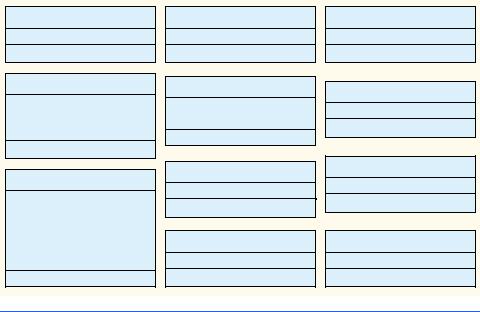
Chapter 4 |
Control Structures: Part 1 |
187 |
ElevatorModel
numberOfPeople : Integer=0
Person
ID : Integer
moving : Boolean = true currentFloor : Integer
Elevator
moving : Boolean = false summoned : Boolean = false currentFloor : Integer = 1 destinationFloor : Integer = 2 capacity : Integer = 1 travelTime : Integer = 5
ElevatorShaft
<none yet>
Floor
floorNumber : Integer capacity : Integer = 1
ElevatorButton
pressed : Boolean = false
FloorButton
pressed : Boolean = false
ElevatorDoor
open : Boolean = false
Light
lightOn : Boolean = false
Bell
<none yet>
FloorDoor
open : Boolean = false
Fig. 4.18 Classes with attributes.
SUMMARY
•A procedure for solving a problem in terms of the actions to be executed and the order in which the actions should be executed is called an algorithm.
•Specifying the order in which statements execute in a computer program is called program control.
•Pseudocode helps the programmer “think out” a program before attempting to write it in a programming language, such as Java.
•Top-down, stepwise refinement is a process for refining pseudocode by maintaining a complete representation of the program during each refinement.
•Declarations are messages to the compiler telling it the names and attributes of variables and telling it to reserve space for variables.
•A selection structure chooses among alternative courses of action.
•The if selection structure executes an indicated action only when the condition is true.
•The if/else selection structure specifies separate actions to execute when the condition is true and when the condition is false.
•When more than one statement should execute where normally only a single statement appears, the statements must be enclosed in braces, forming a block. A block can be placed anywhere a single statement can be placed.
•An empty statement, indicating that no action is to be taken, is indicated by placing a semicolon (;) where a statement would normally be.
•A repetition structure specifies that an action is to be repeated while some condition remains true.
•The format for the while repetition structure is
while ( condition ) statement
© Copyright 1992–2002 by Deitel & Associates, Inc. All Rights Reserved. 7/2/01
188 |
Control Structures: Part 1 |
Chapter 4 |
•A value that contains a fractional part is referred to as a floating-point number and is represented by the data type float or double.
•Unary cast operator (double) creates a temporary floating-point copy of its operand.
•Java provides the arithmetic assignment operators +=, -=, *=, /= and %=, which help abbreviate certain common types of expressions.
•The increment operator, ++, and the decrement operator, --, increment or decrement a variable by 1, respectively. If the operator is prefixed to the variable, the variable is incremented or decremented by 1 first, and then used in its expression. If the operator is postfixed to the variable, the variable is used in its expression, and then incremented or decremented by 1.
•The primitive types (boolean, char, byte, short, int, long, float and double) are the building blocks for more complicated types in Java.
•Java requires all variables to have a type before they can be used in a program. For this reason, Java is referred to as a strongly typed language.
•Primitive types in Java are portable across all computer platforms that support Java.
•Java uses internationally recognized standards for both character formats (Unicode) and floatingpoint numbers (IEEE 754).
•Instance variables of types char, byte, short, int, long, float and double are all given the value 0 by default. Variables of type boolean are given the value false by default.
TERMINOLOGY
-- operator |
integer division |
?: operator |
ISO Unicode character set |
++ operator |
logic error |
action |
loop counter |
action/decision model |
loop-continuation condition |
algorithm |
nested control structures |
arithmetic assignment operators: |
postdecrement operator |
+=, -=, *=, /= and %= |
postincrement operator |
block |
predecrement operator |
body of a loop |
preincrement operator |
cast operator, ( type ) |
promotion |
conditional operator (?:) |
pseudocode |
control structure |
repetition |
counter-controlled repetition |
repetition structures |
decision |
selection |
decrement operator (--) |
sentinel value |
definite repetition |
sequential execution |
double |
single-entry/single-exit control structures |
double-selection structure |
single-selection structure |
empty statement (;) |
stacked control structures |
if selection structure |
structured programming |
if/else selection structure |
syntax error |
implicit conversion |
top-down, stepwise refinement |
increment operator (++) |
unary operator |
indefinite repetition |
while repetition structure |
infinite loop |
white-space characters |
initialization |
|
© Copyright 1992–2002 by Deitel & Associates, Inc. All Rights Reserved. 7/2/01
Chapter 4 |
Control Structures: Part 1 |
189 |
SELF-REVIEW EXERCISES
4.1Fill in the blanks in each of the following statements:
a) |
All programs can be written in terms of three types of control structures: |
, |
||||||||
|
|
|
and |
. |
|
|
|
|
||
|
|
|
|
|
|
|
|
|
||
b) |
The |
|
|
|
selection structure is used to execute one action when a condition is true |
|||||
|
and another action when that condition is false. |
|
|
|
||||||
c) |
Repeating a set of instructions a specific number of times is called |
|
|
repetition. |
||||||
d) |
When it is not known in advance how many times a set of statements will be repeated, a |
|||||||||
|
|
|
value can be used to terminate the repetition. |
|
|
|
||||
4.2Write four different Java statements that each add 1 to integer variable x.
4.3Write Java statements to accomplish each of the following tasks:
a)Assign the sum of x and y to z, and increment the value of x by 1 after the calculation. Use only one statement.
b)Test if the value of the variable count is greater than 10. If it is, print "Count is greater than 10".
c)Decrement the variable x by 1, and then subtract it from the variable total. Use only one statement.
d)Calculate the remainder after q is divided by divisor, and assign the result to q. Write this statement in two different ways.
4.4Write a Java statement to accomplish each of the following tasks:
a)Declare variables sum and x to be of type int.
b)Assign 1 to variable x.
c)Assign 0 to variable sum.
d)Add variable x to variable sum, and assign the result to variable sum.
e)Print "The sum is: ", followed by the value of variable sum.
4.5Combine the statements that you wrote in Exercise 4.4 into a Java application that calculates and prints the sum of the integers from 1 to 10. Use the while structure to loop through the calculation and increment statements. The loop should terminate when the value of x becomes 11.
4.6Determine the value of each variable after the calculation is performed. Assume that when each statement begins executing, all variables have the integer value 5.
a)product *= x++;
b)quotient /= ++x;
4.7Identify and correct the errors in each of the following sets of code:
a)while ( c <= 5 ) {
product *= c; ++c;
b) if ( gender == 1 )
System.out.println( "Woman" ); else;
System.out.println( "Man" );
4.8What is wrong with the following while repetition structure?
while ( z >= 0 ) sum += z;
ANSWERS TO SELF-REVIEW EXERCISES
4.1 a) sequence, selection, repetition. b) if/else. c) counter-controlled, or definite. d) Sentinel, signal, flag or dummy.
© Copyright 1992–2002 by Deitel & Associates, Inc. All Rights Reserved. 7/2/01
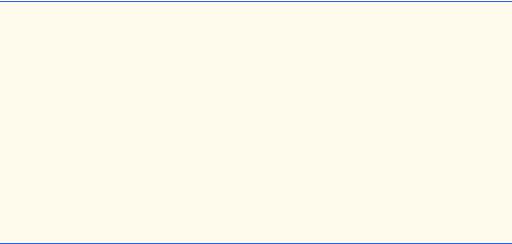
190 |
Control Structures: Part 1 |
Chapter 4 |
4.2x = x + 1; x += 1; ++x;
x++;
4.3a) z = x++ + y;
b) if ( count > 10 )
System.out.println( "Count is greater than 10" );
c)total -= --x;
d)q %= divisor;
q = q % divisor;
4.4a) int sum, x;
b)x = 1;
c)sum = 0;
d) sum += x; or sum = sum + x;
e)System.out.println( "The sum is: " + sum );
4.5The program is as follows:
1 // Calculate the sum of the integers from 1 to 10
2public class Calculate {
3public static void main( String args[] )
4{
5 int sum, x;
6
7x = 1;
8 |
sum = 0; |
9 |
|
10 |
while ( x <= 10 ) { |
11 |
sum += x; |
12++x;
13}
14
15System.out.println( "The sum is: " + sum );
16}
17}
4.6a) product = 25, x = 6
b)quotient = 0, x = 6
4.7a) Error: Missing the closing right brace of the while structure’s body. Correction: Add a closing right brace after the statement ++c;.
b)Error: Semicolon after else results in a logic error. The second output statement will always be executed.
Correction: Remove the semicolon after else.
4.8The value of the variable z is never changed in the while structure. Therefore, if the loopcontinuation condition ( z >= 0 ) is true, an infinite loop is created. To prevent an infinite loop from occurring, z must be decremented so that it eventually becomes less than 0.
EXERCISES
4.9 Identify and correct the errors in each of the following sets of code. [Note: There may be more than one error in each piece of code]:
© Copyright 1992–2002 by Deitel & Associates, Inc. All Rights Reserved. 7/2/01
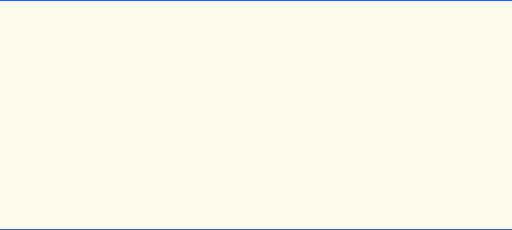
Chapter 4 |
Control Structures: Part 1 |
191 |
a) |
if ( age >= 65 ); |
|
System.out.println( "Age greater than or equal to 65" ); else
System.out.println( "Age is less than 65 )";
b)int x = 1, total; while ( x <= 10 ) {
total += x; ++x;
}
c)While ( x <= 100 ) total += x; ++x;
d)while ( y > 0 ) {
System.out.println( y ); ++y;
4.10What does the following program print?
1 public class Mystery {
2
3public static void main( String args[] )
4{
5 int y, x = 1, total = 0;
6
7while ( x <= 10 ) {
8y = x * x;
9System.out.println( y );
10 |
total += y; |
11++x;
12}
13
14System.out.println( "Total is " + total );
15}
16}
For Exercise 4.11 through Exercise 4.14, perform each of the following steps:
a)Read the problem statement.
b)Formulate the algorithm using pseudocode and top-down, stepwise refinement.
c)Write a Java program.
d)Test, debug and execute the Java program.
e)Process three complete sets of data.
4.11Drivers are concerned with the mileage obtained by their automobiles. One driver has kept track of several tankfuls of gasoline by recording miles driven and gallons used for each tankful. Develop a Java application that will input the miles driven and gallons used (both as integers) for each tankful. The program should calculate and display the miles per gallon obtained for each tankful and print the combined miles per gallon obtained for all tankfuls up to this point. All averaging calculations should produce floating-point results. Use input dialogs to obtain the data from the user.
4.12Develop a Java application that will determine if a department-store customer has exceeded the credit limit on a charge account. For each customer, the following facts are available:
a)account number,
b)balance at the beginning of the month,
©Copyright 1992–2002 by Deitel & Associates, Inc. All Rights Reserved. 7/2/01
192 |
Control Structures: Part 1 |
Chapter 4 |
c)total of all items charged by the customer this month,
d)total of all credits applied to the customer's account this month, and
e)allowed credit limit.
The program should input each of these facts from input dialogs as integers, calculate the new balance (= beginning balance + charges – credits), display the new balance and determine if the new balance exceeds the customer's credit limit. For those customers whose credit limit is exceeded, the program should display the message “Credit limit exceeded.”
4.13 A large company pays its salespeople on a commission basis. The salespeople receive $200 per week, plus 9% of their gross sales for that week. For example, a salesperson who sells $5000 worth of merchandise in a week receives $200 plus 9% of $5000, or a total of $650. You have been supplied with a list of items sold by each salesperson. The values of these items are as follows:
Item Value
1239.99
2129.75
3 99.95
4350.89
Develop a Java application that inputs one salesperson's items sold for last week and calculates and displays that salesperson's earnings. There is no limit to the number of items that can be sold by a salesperson.
4.14Develop a Java application that will determine the gross pay for each of three employees. The company pays “straight time” for the first 40 hours worked by each employee and pays “time and a half” for all hours worked in excess of 40 hours. You are given a list of the employees of the company, the number of hours each employee worked last week and the hourly rate of each employee. Your program should input this information for each employee and should determine and display the employee's gross pay. Use input dialogs to input the data.
4.15The process of finding the largest value (i.e., the maximum of a group of values) is used frequently in computer applications. For example, a program that determines the winner of a sales contest would input the number of units sold by each salesperson. The salesperson who sells the most units wins the contest. Write a pseudocode program and then a Java application that inputs a series of 10 single-digit numbers as characters and determines and prints the largest of the numbers. Hint: Your program should use the following three variables:
a)counter: A counter to count to 10 (i.e., to keep track of how many numbers have been input and to determine when all 10 numbers have been processed);
b)number: The current digit input to the program;
c)largest: The largest number found so far.
4.16Write a Java application that uses looping to print the following table of values:
N |
10*N |
100*N |
1000*N |
1 |
10 |
100 |
1000 |
2 |
20 |
200 |
2000 |
3 |
30 |
300 |
3000 |
4 |
40 |
400 |
4000 |
5 |
50 |
500 |
5000 |
|
|
|
|
4.17 Using an approach similar to that for Exercise 4.15, find the two largest values of the 10 digits entered. [Note: You may input each number only once.]
© Copyright 1992–2002 by Deitel & Associates, Inc. All Rights Reserved. 7/2/01
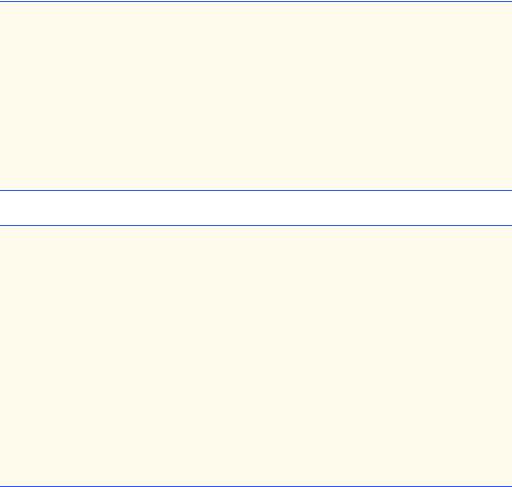
Chapter 4 |
Control Structures: Part 1 |
193 |
4.18Modify the program in Fig. 4.11 to validate its inputs. For any input, if the value entered is other than 1 or 2, keep looping until the user enters a correct value.
4.19What does the following program print?
1 public class Mystery2 {
2
3public static void main( String args[] )
4{
5 int count = 1;
6
7while ( count <= 10 ) {
8System.out.println(
9 |
count % 2 == 1 ? "****" : "++++++++" ); |
10++count;
11}
12}
13}
4.20What does the following program print?
1 public class Mystery3 {
2
3public static void main( String args[] )
4{
5 int row = 10, column;
6
7while ( row >= 1 ) {
8 |
column = 1; |
9 |
|
10 |
while ( column <= 10 ) { |
11 |
System.out.print( row % 2 == 1 ? "<" : ">" ); |
12 |
++column; |
13 |
} |
14 |
|
15 |
--row; |
16System.out.println();
17}
18}
19}
4.21(Dangling-Else Problem) Determine the output for each of the given sets of code when x is 9 and y is 11 and when x is 11 and y is 9. Note that the compiler ignores the indentation in a Java program. Also, the Java compiler always associates an else with the previous if unless told to do otherwise by the placement of braces ({}). On first glance, the programmer may not be sure which if an else matches; this situation is referred to as the “dangling-else problem.” We have eliminated the indentation from the following code to make the problem more challenging. [Hint: Apply indentation conventions you have learned.]
a)if ( x < 10 ) if ( y > 10 )
System.out.println( "*****" ); else
System.out.println( "#####" ); System.out.println( "$$$$$" );
©Copyright 1992–2002 by Deitel & Associates, Inc. All Rights Reserved. 7/2/01
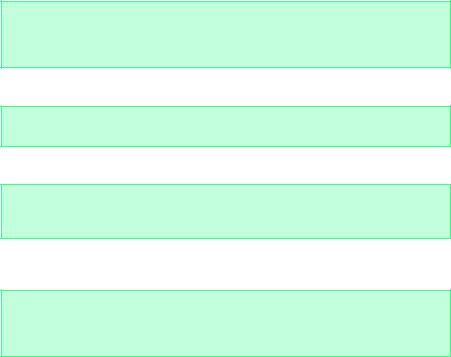
194 |
Control Structures: Part 1 |
Chapter 4 |
b)if ( x < 10 ) { if ( y > 10 )
System.out.println( "*****" );
}
else {
System.out.println( "#####" ); System.out.println( "$$$$$" );
}
4.22(Another Dangling-Else Problem) Modify the given code to produce the output shown in each part of the problem. Use proper indentation techniques. You may not make any changes other than inserting braces and changing the indentation of the code. The compiler ignores indentation in a Java program. We have eliminated the indentation from the given code to make the problem more challenging. [Note: It is possible that no modification is necessary for some of the parts.]
if ( y == 8 ) if ( x == 5 )
System.out.println( "@@@@@" ); else
System.out.println( "#####" ); System.out.println( "$$$$$" ); System.out.println( "&&&&&" );
a) Assuming that x = 5 and y = 8, the following output is produced:
@@@@@
$$$$$
&&&&&
b) Assuming that x = 5 and y = 8, the following output is produced:
@@@@@
c) Assuming that x = 5 and y = 8, the following output is produced:
@@@@@
&&&&&
d)Assuming that x = 5 and y = 7, the following output is produced [Note: The last three output statements after the else are all part of a block]:]
#####
$$$$$
&&&&&
4.23 Write an applet that reads in the size of the side of a square and displays a hollow square of that size out of asterisks, by using the drawString method inside your applet’s paint method.
© Copyright 1992–2002 by Deitel & Associates, Inc. All Rights Reserved. 7/2/01

Chapter 4 |
Control Structures: Part 1 |
195 |
Use an input dialog to read the size from the user. Your program should work for squares of all lengths of side between 1 and 20.
4.24A palindrome is a number or a text phrase that reads the same backward as forward. For example, each of the following five-digit integers are palindromes: 12321, 55555, 45554 and 11611. Write an application that reads in a five-digit integer and determines whether or not it is a palindrome. If the number is not five digits long, display an error message dialog indicating the problem to the user. When the user dismisses the error dialog, allow the user to enter a new value.
4.25Write an application that inputs an integer containing only 0s and 1s (i.e., a “binary” integer) and prints its decimal equivalent. [Hint: Use the modulus and division operators to pick off the “binary number’s” digits one at a time, from right to left. Just as in the decimal number system, where the rightmost digit has a positional value of 1 and the next digit to the left has a positional value of 10, then 100, then 1000, etc., in the binary number system the rightmost digit has a positional value of 1, the next digit to the left has a positional value of 2, then 4, then 8, etc. Thus, the decimal number 234 can be interpreted as 4 * 1 + 3 * 10 + 2 * 100. The decimal equivalent of binary 1101 is 1 * 1 + 0 * 2 + 1 * 4 + 1 * 8, or 1 + 0 + 4 + 8 or, 13.]
4.26Write an application that displays the following checkerboard pattern:
** * * * * * *
* * * * * * * *
** * * * * * *
* * * * * * * *
** * * * * * *
* * * * * * * *
** * * * * * *
* * * * * * * *
Your program may use only three output statements, one of the form
System.out.print( "* " );
one of the form
System.out.print( " " );
and one of the form
System.out.println();
Note that the preceding statement indicates that the program should output a single newline character to drop to the next line of the output. [Hint: Repetition structures are required in this exercise.]
4.27Write an application that keeps displaying in the command window the multiples of the integer 2, namely 2, 4, 8, 16, 32, 64, etc. Your loop should not terminate (i.e., you should create an infinite loop). What happens when you run this program?
4.28What is wrong with the following statement? Provide the correct statement to add one to the sum of x and y.
System.out.println( ++(x + y) );
4.29 Write an application that reads three nonzero values entered by the user in input dialogs and determines and prints if they could represent the sides of a triangle.
© Copyright 1992–2002 by Deitel & Associates, Inc. All Rights Reserved. 7/2/01
196 |
Control Structures: Part 1 |
Chapter 4 |
4.30Write an application that reads three nonzero integers and determines and prints if they could represent the sides of a right triangle.
4.31A company wants to transmit data over the telephone, but it is concerned that its phones may be tapped. All of its data are transmitted as four-digit integers. It has asked you to write a program that will encrypt its data so that the data may be transmitted more securely. Your application should read a four-digit integer entered by the user in an input dialog and encrypt it as follows: Replace each digit by (the sum of that digit plus 7) modulus 10. Then swap the first digit with the third, and swap the second digit with the fourth. Then print the encrypted integer. Write a separate application that inputs an encrypted four-digit integer and decrypts it to form the original number.
4.32The factorial of a nonnegative integer n is written as n! (pronounced “n factorial”) and is defined as follows:
n! = n · (n - 1) · (n - 2) · … · 1 (for values of n greater than or equal to 1)
and
n! = 1 (for n = 0).
For example, 5! = 5 · 4 · 3 · 2 · 1, which is 120.
a)Write an application that reads a nonnegative integer from an input dialog and computes and prints its factorial.
b)Write an application that estimates the value of the mathematical constant e by using the formula
1 1 1 … e = 1 + ---- + ---- + ---- +
1! 2! 3!
c) Write an application that computes the value of ex by using the formula:
e |
x |
= 1 |
x |
x2 |
x3 |
|
+ ---- |
+ ---- + ---- + … |
|||
|
|
|
1! |
2! |
3! |
© Copyright 1992–2002 by Deitel & Associates, Inc. All Rights Reserved. 7/2/01
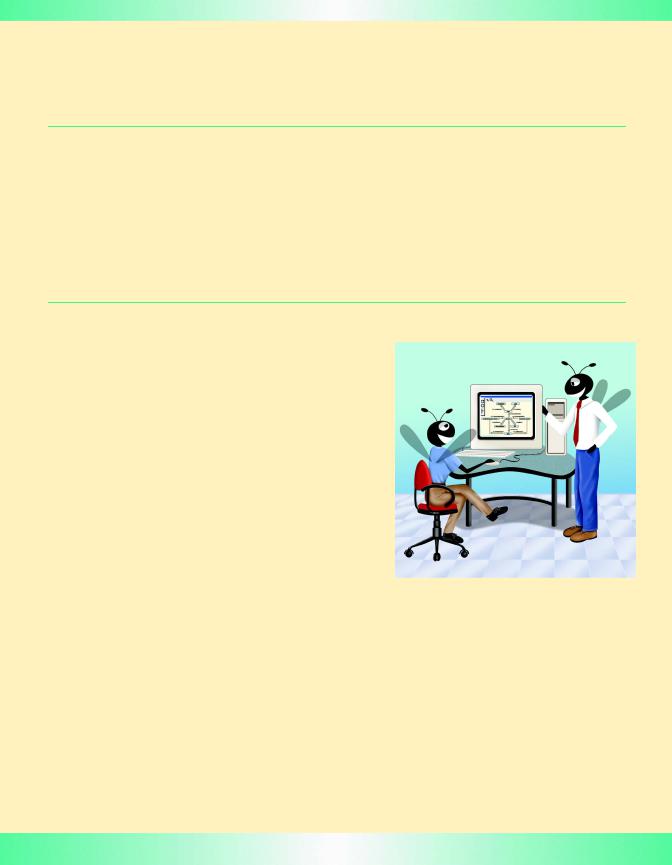
5
Control Structures:
Part 2
Objectives
•To be able to use the for and do/while repetition structures to execute statements in a program repeatedly.
•To understand multiple selection using the switch selection structure.
•To be able to use the break and continue program control statements.
•To be able to use the logical operators.
Who can control his fate?
William Shakespeare, Othello
The used key is always bright.
Benjamin Franklin
Man is a tool-making animal.
Benjamin Franklin
Intelligence … is the faculty of making artificial objects, especially tools to make tools.
Henri Bergson
© Copyright 1992–2002 by Deitel & Associates, Inc. All Rights Reserved. 7/2/01

198 |
Control Structures: Part 2 |
Chapter 5 |
Outline
5.1Introduction
5.2Essentials of Counter-Controlled Repetition
5.3The for Repetition Structure
5.4Examples Using the for Structure
5.5The switch Multiple-Selection Structure
5.6The do/while Repetition Structure
5.7Statements break and continue
5.8Labeled break and continue Statements
5.9Logical Operators
5.10Structured Programming Summary
5.11(Optional Case Study) Thinking About Objects: Identifying Objects’ States and Activities
Summary • Terminology • Self-Review Exercises • Answers to Self-Review Exercises • Exercises
5.1 Introduction
Chapter 4 began our introduction to the types of building blocks that are available for problem solving and used those building blocks to employ proven program construction principles. In this chapter, we continue our presentation of the theory and principles of structured programming by introducing Java’s remaining control structures. As in Chapter 4, the Java techniques you learn here are applicable to most high-level languages. When we begin our formal treatment of object-based programming in Java in Chapter 8, we will see that the control structures we study in this chapter and Chapter 4 are helpful in building and manipulating objects.
5.2 Essentials of Counter-Controlled Repetition
Counter-controlled repetition requires the following:
1.the name of a control variable (or loop counter),
2.the initial value of the control variable,
3.the amount of increment (or decrement) by which the control variable is modified each time through the loop (also known as each iteration of the loop), and
4.the condition that tests for the final value of the control variable (i.e., whether looping should continue).
To see the four elements of counter-controlled repetition, consider the applet shown in Fig. 5.1, which draws 10 lines from the applet’s paint method. Remember that an applet requires a separate HTML document to load the applet into the appletviewer or a browser. For the purpose of this applet, the <applet> tag specifies a width of 275 pixels and a height of 110 pixels.
© Copyright 1992–2002 by Deitel & Associates, Inc. All Rights Reserved. 7/2/01
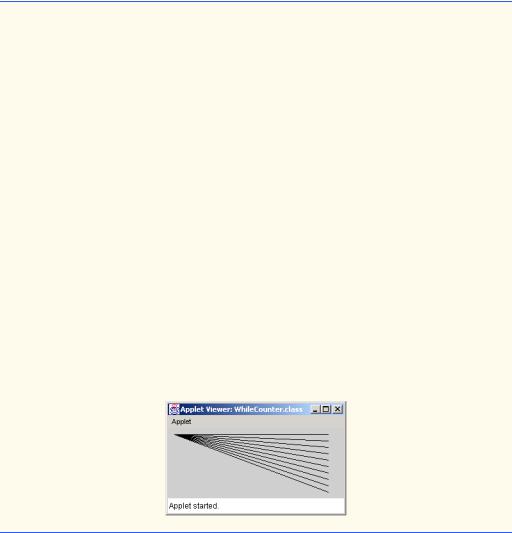
Chapter 5 |
Control Structures: Part 2 |
199 |
1// Fig. 5.1: WhileCounter.java
2 // Counter-controlled repetition
3
4// Java core packages
5 import java.awt.Graphics;
6
7 // Java extension packages
8 import javax.swing.JApplet;
9
10 public class WhileCounter extends JApplet {
11
12// draw lines on applet’s background
13public void paint( Graphics g )
14{
15// call inherited version of method paint
16super.paint( g );
17 |
|
|
18 |
int counter = 1; |
// initialization |
19 |
|
|
20 |
while ( counter <= 10 ) { |
// repetition condition |
21 |
g.drawLine( 10, 10, 250, counter * 10 ); |
|
22 |
++counter; |
// increment |
23 |
|
|
24 |
} // end while structure |
|
25 |
|
|
26 |
} // end method paint |
|
27 |
|
|
28 |
} // end class WhileCounter |
|
Fig. 5.1 Counter-controlled repetition.
The applet’s paint method (that the applet container calls when it executes the applet) operates as follows: The declaration on line 18 names the control variable (counter), declares it to be an integer, reserves space for it in memory and sets it to an initial value of 1. Declarations that include initialization are, in effect, executable statements. The declaration and initialization of counter could also have been accomplished with the declaration and statement
int counter; // declare counter counter = 1; // initialize counter to 1
The declaration is not executable, but the assignment statement is. We use both methods of initializing variables throughout this book.
© Copyright 1992–2002 by Deitel & Associates, Inc. All Rights Reserved. 7/2/01
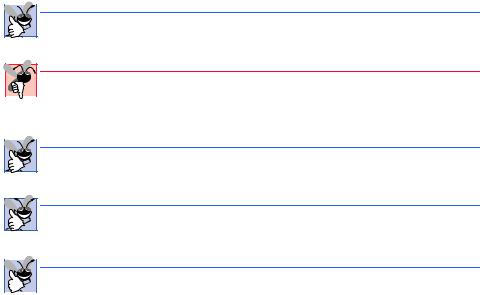
200 |
Control Structures: Part 2 |
Chapter 5 |
Line 21 in the while structure uses Graphics reference g, which refers to the applet’s Graphics object, to send the drawLine message to the Graphics object, asking it to draw a line. Remember that “sending a message to an object” actually means calling a method to perform a task. One of the Graphics object’s many services is to draw lines. In previous chapters, we also saw that the Graphics object’s other services include drawing rectangles, strings and ovals. Graphics method drawLine requires four arguments, representing the line’s first x-coordinate, first y-coordinate, second x-coor- dinate and second y-coordinate. In this example, the second y-coordinate changes value during each iteration of the loop with the calculation counter * 10. This change causes the second point (the end point of the line) in each call to drawLine to move 10 pixels down the applet’s display area.
Line 22 in the while structure increments the control variable by 1 for each iteration of the loop. The loop-continuation condition in the while structure tests whether the value of the control variable is less than or equal to 10 (the final value for which the condition is true). Note that the program performs the body of this while structure even when the control variable is 10. The loop terminates when the control variable exceeds 10 (i.e., counter becomes 11).
The program in Fig. 5.1 can be made more concise by initializing counter to 0 and preincrementing counter in the while structure condition as follows:
while ( ++counter <= 10 ) // repetition condition g.drawLine( 10, 10, 250, counter * 10 );
This code saves a statement (and eliminates the need for braces around the loop’s body), because the while condition performs the increment before testing the condition. (Remember that the precedence of ++ is higher than that of <=.) Coding in such a condensed fashion takes practice.
 Good Programming Practice 5.1
Good Programming Practice 5.1
Programs should control counting loops with integer values.
Common Programming Error 5.1

 Because floating-point values may be approximate, controlling the counting of loops with
Because floating-point values may be approximate, controlling the counting of loops with  floating-point variables may result in imprecise counter values and inaccurate tests for termination.
floating-point variables may result in imprecise counter values and inaccurate tests for termination.
 Good Programming Practice 5.2
Good Programming Practice 5.2
Indent the statements in the body of each control structure.
Good Programming Practice 5.3
Put a blank line before and after each major control structure to make it stand out in the program.
 Good Programming Practice 5.4
Good Programming Practice 5.4
Too many levels of nesting can make a program difficult to understand. As a general rule, try  to avoid using more than three levels of nesting.
to avoid using more than three levels of nesting.
© Copyright 1992–2002 by Deitel & Associates, Inc. All Rights Reserved. 7/2/01
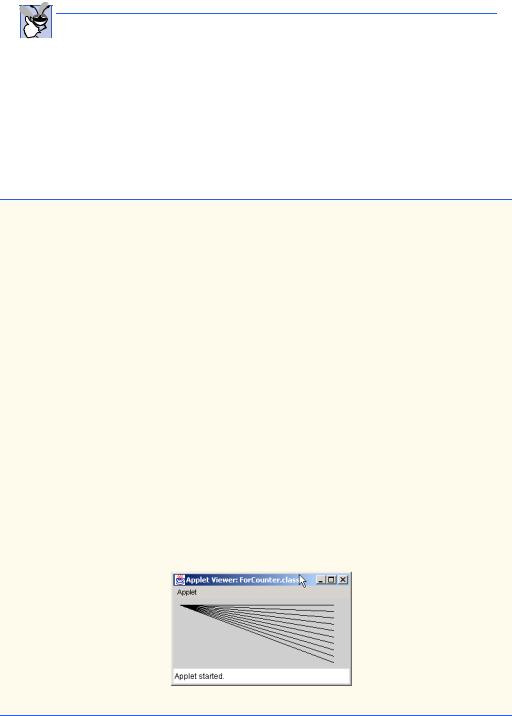
Chapter 5 |
Control Structures: Part 2 |
201 |
Good Programming Practice 5.5
Vertical spacing above and below control structures, and indentation of the bodies of control  structures within the control structures’ headers, gives programs a two-dimensional appearance that enhances readability.
structures within the control structures’ headers, gives programs a two-dimensional appearance that enhances readability.
5.3 The for Repetition Structure
The for repetition structure handles all of the details of counter-controlled repetition. To illustrate the power of the for structure, let us rewrite the applet of Fig. 5.1. The result is shown in Fig. 5.2. Remember that this program requires a separate HTML document to load the applet into the appletviewer. For the purpose of this applet, the <applet> tag specifies a width of 275 pixels and a height of 110 pixels.
1// Fig. 5.2: ForCounter.java
2 // Counter-controlled repetition with the for structure
3
4// Java core packages
5 import java.awt.Graphics;
6
7 // Java extension packages
8 import javax.swing.JApplet;
9
10 public class ForCounter extends JApplet {
11
12// draw lines on applet’s background
13public void paint( Graphics g )
14{
15// call inherited version of method paint
16super.paint( g );
17
18// Initialization, repetition condition and incrementing
19// are all included in the for structure header.
20for ( int counter = 1; counter <= 10; counter++ )
21 |
|
g.drawLine( 10, 10, 250, counter * 10 ); |
22 |
|
|
23 |
} |
// end method paint |
24 |
|
|
25 |
} // |
end class ForCounter |
Fig. 5.2 Counter-controlled repetition with the for structure.
© Copyright 1992–2002 by Deitel & Associates, Inc. All Rights Reserved. 7/2/01
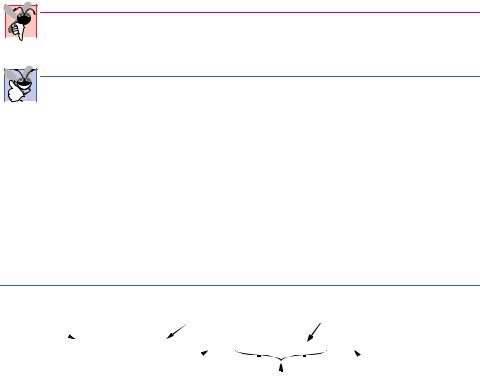
202 |
Control Structures: Part 2 |
Chapter 5 |
The applet’s paint method operates as follows: When the for structure (lines 20– 21) begins executing, the control variable counter is initialized to 1. (The first two elements of counter-controlled repetition and the name of the control variable and its initial value.) Next, the program checks the loop-continuation condition, counter <= 10. The condition contains the final value (10) of the control variable. Because the initial value of counter is 1, the condition is satisfied (true), so the body statement (line 21) draws a line. After executing the body of the loop, the program increments variable counter in the expression counter++. Then, the program performs the loop-continuation test again to determine whether the program should continue with the next iteration of the loop or whether it should terminate the loop. At this point, the control variable value is 2, so the condition is true (i.e., the final value is not exceeded), and thus the program performs the body statement again (i.e., the next iteration of the loop). This process continues until the counter’s value becomes 11, causing the loop-continuation test to fail and repetition to terminate. Then, the program performs the first statement after the for structure. (In this case, method paint terminates, because the program reaches the end of paint.)
Notice that Fig. 5.2 uses the loop-continuation condition counter <= 10. If the programmer incorrectly specified counter < 10 as the condition, the loop would be executed only nine times. This mistake is a common logic error called an off-by-one error.
Common Programming Error 5.2

 Using an incorrect relational operator or using an incorrect final value of a loop counter in
Using an incorrect relational operator or using an incorrect final value of a loop counter in  the condition of a while, for or do/while structure can cause an off-by-one error.
the condition of a while, for or do/while structure can cause an off-by-one error.
Good Programming Practice 5.6
Using the final value in the condition of a while or for structure and using the <= rela-  tional operator will help avoid off-by-one errors. For a loop that prints the values 1 to 10, the loop-continuation condition should be counter <= 10 rather than counter < 10 (which causes an off-by-one error) or counter < 11 (which is correct). Many programmers prefer so-called zero-based counting, in which to count 10 times, counter would be initialized to zero and the loop-continuation test would be counter < 10.
tional operator will help avoid off-by-one errors. For a loop that prints the values 1 to 10, the loop-continuation condition should be counter <= 10 rather than counter < 10 (which causes an off-by-one error) or counter < 11 (which is correct). Many programmers prefer so-called zero-based counting, in which to count 10 times, counter would be initialized to zero and the loop-continuation test would be counter < 10.
Figure 5.3 takes a closer look at the for structure of Fig. 5.2. The for structure’s first line (including the keyword for and everything in parentheses after for) is sometimes called the for structure header. Notice that the for structure “does it all”: It specifies each of the items needed for counter-controlled repetition with a control variable. If there is more than one statement in the body of the for structures, braces ({ and }) are required to define the body of the loop.
for keyword |
Control variable name |
|
Final value of control variable |
|
for ( int counter = 1; counter <= 10; counter++ ) |
||
Initial value of control variable |
|
Increment of control variable |
|
|
|||
|
Loop-continuation condition |
||
|
|
|
|
|
|
|
|
Fig. 5.3 Components of a typical for structure header.
© Copyright 1992–2002 by Deitel & Associates, Inc. All Rights Reserved. 7/2/01
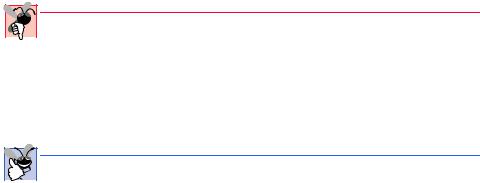
Chapter 5 Control Structures: Part 2 203
The general format of the for structure is
for ( expression1; expression2; expression3 ) statement
where expression1 names the loop’s control variable and provides its initial value, expression2 is the loop-continuation condition (containing the control variable’s final value) and expression3 modifies the value of the control variable, so that the loop-continuation condition eventually becomes false. In most cases, the for structure can be represented with an equivalent while structure, with expression1, expression2 and expression3 placed as follows:
expression1;
while ( expression2 ) { statement
expression3;
}
In Section 5.7, we show a case in which a for structure cannot be represented with an equivalent while structure.
If expression1 (the initialization section) declares the control variable inside the parentheses of the header of the for structure (i.e., the control variable’s type is specified before the name of the variable), the control variable can be used only in the for structure. This restricted use of the name of the control variable is known as the variable’s scope. The scope of a variable defines where the program can use the variable. For example, we mentioned previously that a program can use a local variable only in the method that declares the variable. Scope is discussed in detail in Chapter 6, “Methods.”
Common Programming Error 5.3

 When the control variable of a for structure is initially defined in the initialization section
When the control variable of a for structure is initially defined in the initialization section  of the header of the for structure, using the control variable after the body of the structure is a syntax error.
of the header of the for structure, using the control variable after the body of the structure is a syntax error.
Sometimes, expression1 and expression3 in a for structure are comma-separated lists of expressions that enable the programmer to use multiple initialization expressions and/or multiple increment expressions. For example, there may be several control variables in a single for structure that must be initialized and incremented.
Good Programming Practice 5.7
Place only expressions involving the control variables in the initialization and increment sec-  tions of a for structure. Manipulations of other variables should appear either before the loop (if they execute only once, like initialization statements) or in the body of the loop (if they execute once per iteration of the loop, like incrementing or decrementing statements).
tions of a for structure. Manipulations of other variables should appear either before the loop (if they execute only once, like initialization statements) or in the body of the loop (if they execute once per iteration of the loop, like incrementing or decrementing statements).
The three expressions in the for structure are optional. If expression2 is omitted, Java assumes that the loop-continuation condition is true, thus creating an infinite loop. One might omit expression1 if the program initializes the control variable before the loop. One might omit expression3 if the program calculates the increment with statements in the loop’s body or if the loop does not require an increment. The increment expression in the for structure acts as a stand-alone statement at the end of the body of the for structure, so the expressions
© Copyright 1992–2002 by Deitel & Associates, Inc. All Rights Reserved. 7/2/01
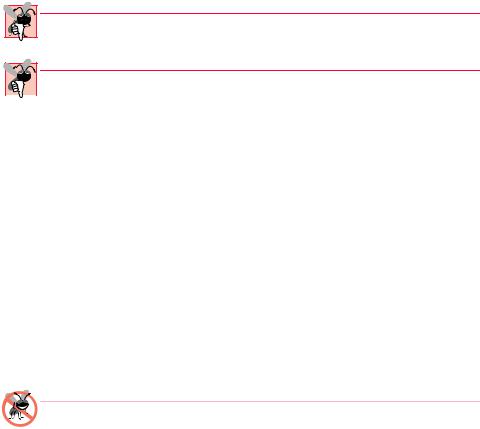
204 |
Control Structures: Part 2 |
Chapter 5 |
counter = counter + 1 counter += 1 ++counter
counter++
are equivalent in the increment portion of the for structure. Many programmers prefer the form counter++, because a for structure increments its control variable after the body of the loop executes and placing ++ after the variable name increments the variable after the program uses its value. Therefore, the postincrementing form seems more natural. Preincrementing and postincrementing have the same effect in the increment expression, because the increment does not appear in a larger expression. The two semicolons in the for structure are required.
Common Programming Error 5.4
Using commas instead of the two required semicolons in a for header is a syntax error.
Common Programming Error 5.5

 Placing a semicolon immediately to the right of the right parenthesis of a for header makes
Placing a semicolon immediately to the right of the right parenthesis of a for header makes  the body of that for structure an empty statement. This is normally a logic error.
the body of that for structure an empty statement. This is normally a logic error.
The initialization, loop-continuation condition and increment portions of a for structure can contain arithmetic expressions. For example, assume that x = 2 and y = 10. If x and y are not modified in the body of the loop, the statement
for ( int j = x; j <= 4 * x * y; j += y / x )
is equivalent to the statement
for ( int j = 2; j <= 80; j += 5 )
The increment of a for structure may also be negative, in which case it is really a decrement, and the loop actually counts downward.
If the loop-continuation condition is initially false, the program does not perform the body of the for structure. Instead, execution proceeds with the statement following the for structure.
Programs frequently display the control variable value or use it in calculations in loop body. However, this use is not required. It is common to use the control variable for controlling repetition while never mentioning it in the body of the for structure.
Testing and Debugging Tip 5.1
Although the value of the control variable can be changed in the body of a for loop, avoid doing so, because this practice can lead to subtle errors.
We flowchart the for structure much as we do the while structure. For example, the flowchart of the for statement
for ( int counter = 1; counter <= 10; counter++ ) g.drawLine( 10, 10, 250, counter * 10 );
is shown in Fig. 5.4. This flowchart makes it clear that the initialization occurs only once and that the increment occurs each time after the program performs the body statement.
© Copyright 1992–2002 by Deitel & Associates, Inc. All Rights Reserved. 7/2/01
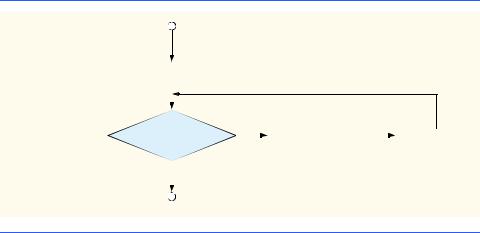
Chapter 5 |
Control Structures: Part 2 |
205 |
Note that, besides small circles and arrows, the flowchart contains only rectangle symbols and a diamond symbol. The programmer fills the rectangles and diamonds with actions and decisions appropriate to the algorithm.
5.4 Examples Using the for Structure
The examples given next show methods of varying the control variable in a for structure. In each case, we write the appropriate for structure header. Note the change in the relational operator for loops that decrement the control variable.
a) Vary the control variable from 1 to 100 in increments of 1.
for ( int i = 1; i <= 100; i++ )
b)Vary the control variable from 100 to 1 in increments of -1 (i.e., decrements of 1).
for ( int i = 100; i >= 1; i-- )
c)Vary the control variable from 7 to 77 in steps of 7.
for ( int i = 7; i <= 77; i += 7 )
d) Vary the control variable from 20 to 2 in steps of -2.
for ( int i = 20; i >= 2; i -= 2 )
e)Vary the control variable over the following sequence of values: 2, 5, 8, 11, 14,
17, 20.
for ( int j = 2; j <= 20; j += 3 )
f)Vary the control variable over the following sequence of values: 99, 88, 77, 66,
55, 44, 33, 22, 11, 0.
for ( int j = 99; j >= 0; j -= 11 )
Establish initial value |
|
|
|
int counter = 1 |
|||
of control variable. |
|||
|
|
|
|
Determine if final |
|
|
true |
g.drawLine( |
|
|
|
|||
value of control |
|
|
|
10, 10, 250, |
|
|
|
|||
counter <= 10 |
counter++ |
|||||||||
variable has been |
|
|
|
counter * 10 |
|
|
||||
|
|
|
|
|
|
|
Increment |
|||
reached. |
|
|
|
|
); |
|
|
|
||
|
|
false |
|
|
|
|
|
|
the control |
|
|
|
|
|
Body of loop |
||||||
|
|
|
|
variable. |
||||||
|
|
|
|
|
(this may be many |
|||||
|
|
|
|
|
|
|||||
|
|
|
|
|
statements) |
|
||||
Fig. 5.4 Flowcharting a typical for repetition structure.
© Copyright 1992–2002 by Deitel & Associates, Inc. All Rights Reserved. 7/2/01
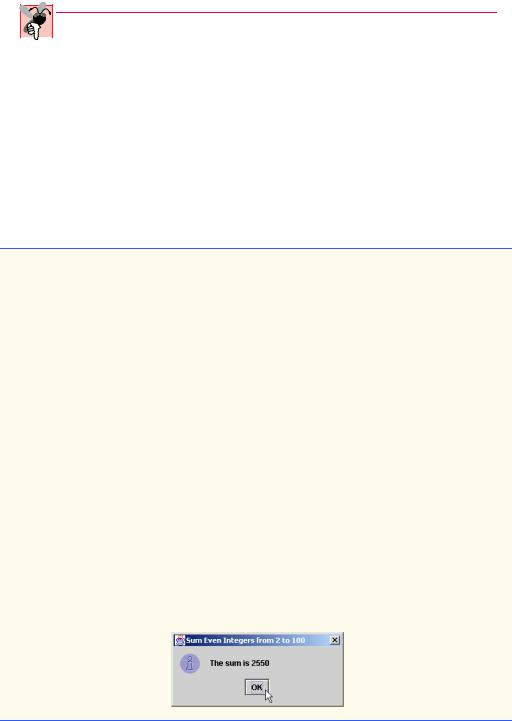
206 |
Control Structures: Part 2 |
Chapter 5 |
Common Programming Error 5.6

 Not using the proper relational operator in the loop-continuation condition of a loop that
Not using the proper relational operator in the loop-continuation condition of a loop that  counts downward (such as using i <= 1 in a loop counting down to 1) is usually a logic error and will yield incorrect results when the program runs.
counts downward (such as using i <= 1 in a loop counting down to 1) is usually a logic error and will yield incorrect results when the program runs.
The next two sample programs demonstrate simple applications of the for repetition structure. The application in Fig. 5.5 uses the for structure to sum all the even integers from 2 to 100. Remember that the java interpreter is used to execute an application from the command window.
Note that the body of the for structure in Fig. 5.5 could actually be merged into the rightmost portion of the for header by using a comma as follows:
for ( int number = 2; number <= 100;
sum += number, number += 2 )
;// empty statement
1// Fig. 5.5: Sum.java
2 // Counter-controlled repetition with the for structure
3
4// Java extension packages
5 import javax.swing.JOptionPane;
6
7 public class Sum {
8
9 // main method begins execution of Java application
10public static void main( String args[] )
11{
12int sum = 0;
13
14// sum even integers from 2 through 100
15for ( int number = 2; number <= 100; number += 2 )
16 |
sum += number; |
17 |
|
18// display results
19JOptionPane.showMessageDialog( null, "The sum is " + sum,
20 |
"Sum Even Integers from 2 to 100", |
21 |
JOptionPane.INFORMATION_MESSAGE ); |
22 |
|
23 |
System.exit( 0 ); // terminate the application |
24 |
|
25 |
} // end method main |
26 |
|
27 |
} // end class Sum |
Fig. 5.5 Summation with the for structure.
© Copyright 1992–2002 by Deitel & Associates, Inc. All Rights Reserved. 7/2/01
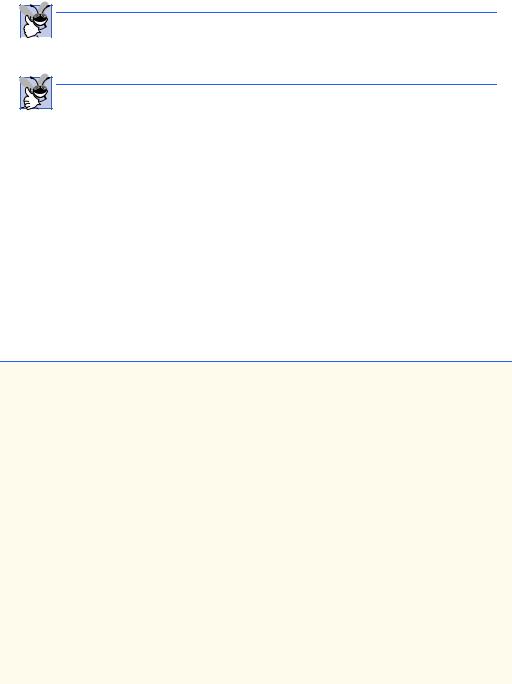
Chapter 5 |
Control Structures: Part 2 |
207 |
Similarly, the initialization sum = 0 could be merged into the initialization section of the for structure.
Good Programming Practice 5.8
Although statements preceding a for structure and statements in the body of a for struc-  ture can often be merged into the header of the for structure, avoid doing so, because it makes the program more difficult to read.
ture can often be merged into the header of the for structure, avoid doing so, because it makes the program more difficult to read.
Good Programming Practice 5.9
Limit the size of control structure headers to a single line. if possible.
The next example uses the for structure to compute compound interest. Consider the following problem:
A person invests $1000.00 in a savings account yielding 5% interest. Assuming that all interest is left on deposit, calculate and print the amount of money in the account at the end of each year for 10 years. Use the following formula to determine the amounts:
a = p (1 + r) n
where
p is the original amount invested (i.e., the principal) r is the annual interest rate
n is the number of years
a is the amount on deposit at the end of the nth year.
This problem involves a loop that performs the indicated calculation for each of the 10 years the money remains on deposit. The solution is the application shown in Fig. 5.6.
1// Fig. 5.6: Interest.java
2 // Calculating compound interest
3
4// Java core packages
5 import java.text.NumberFormat;
6 import java.util.Locale;
7
8// Java extension packages
9 import javax.swing.JOptionPane;
10 import javax.swing.JTextArea;
11
12 public class Interest {
13
14// main method begins execution of Java application
15public static void main( String args[] )
16{
17double amount, principal = 1000.0, rate = 0.05;
19// create DecimalFormat to format floating-point numbers
20// with two digits to the right of the decimal point
21NumberFormat moneyFormat =
22 |
NumberFormat.getCurrencyInstance( Locale.US ); |
23 |
|
|
|
Fig. 5.6 |
Calculating compound interest with the for structure (part 1 of 2). |
© Copyright 1992–2002 by Deitel & Associates, Inc. All Rights Reserved. 7/2/01
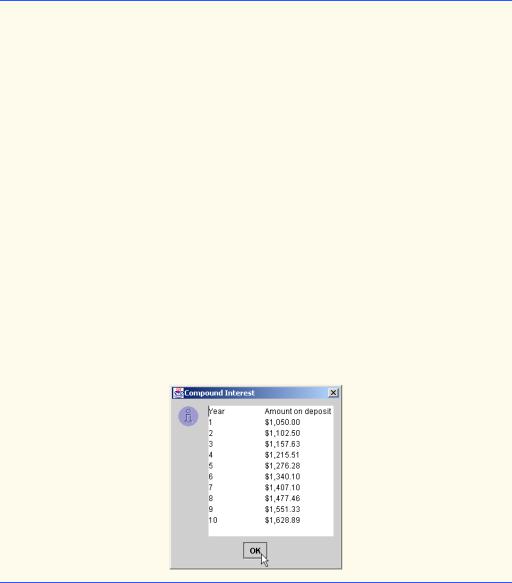
208 |
Control Structures: Part 2 |
Chapter 5 |
24// create JTextArea to display output
25JTextArea outputTextArea = new JTextArea();
27// set first line of text in outputTextArea
28outputTextArea.setText( "Year\tAmount on deposit\n" );
30// calculate amount on deposit for each of ten years
31for ( int year = 1; year <= 10; year++ ) {
32 |
|
33 |
// calculate new amount for specified year |
34 |
amount = principal * Math.pow( 1.0 + rate, year ); |
35 |
|
36 |
// append one line of text to outputTextArea |
37 |
outputTextArea.append( year + "\t" + |
38 |
moneyFormat.format( amount ) + "\n" ); |
39 |
|
40 |
} // end for structure |
41 |
|
42// display results
43JOptionPane.showMessageDialog( null, outputTextArea,
44 |
"Compound Interest", JOptionPane.INFORMATION_MESSAGE ); |
45 |
|
46 |
System.exit( 0 ); // terminate the application |
47 |
|
48 |
} // end method main |
49 |
|
50 |
} // end class Interest |
Fig. 5.6 Calculating compound interest with the for structure (part 2 of 2).
Line 17 in method main declares three double variables and initializes two of them—principal to 1000.0 and rate to .05. Java treats floating-point constants, like 1000.0 and .05 in Fig. 5.6, as type double. Similarly, Java treats whole number constants, like 7 and -22, as type int. Lines 21–22 declare NumberFormat reference moneyFormat and initialize it by calling static method getCurrencyInstance of class NumberFormat. This method returns a NumberFormat object that can format numeric values as currency (e.g., in the United States, currency values normally are preceded with a dollar sign, $). The argument to the method—Locale.US—indicates that
© Copyright 1992–2002 by Deitel & Associates, Inc. All Rights Reserved. 7/2/01
Chapter 5 |
Control Structures: Part 2 |
209 |
the currency values should be displayed starting with a dollar sign ($), use a decimal point to separate dollars and cents and use a comma to delineate thousands (e.g., $1,234.56). Class Locale provides constants that can be used to customize this program to represent currency values for other countries, so that currency formats are displayed properly for each locale (i.e., each country’s local-currency format). Class NumberFormat (imported at line 5) is located in package java.text, and class Locale (imported at line 6) is located in package java.util.
Line 25 declares JTextArea reference outputTextArea and initializes it with a new object of class JTextArea (from package javax.swing). A JTextArea is a GUI component that can display many lines of text. The message dialog that displays the JTextArea determines the width and height of the JTextArea, based on the String it contains. We introduce this GUI component now because we will see many examples throughout the text in which the program outputs contain too many lines to display on the screen. This GUI component allows us to scroll through the lines of text so we can see all the program output. The methods for placing text in a JTextArea include setText and append.
Line 28 uses JTextArea method setText to place a String in the JTextArea to which outputTextArea refers. Initially, a JTextArea contains an empty String (i.e., a String with no characters in it). The preceding statement replaces the empty String with one containing the column heads for our two columns of output—“Year” and “Amount on Deposit.” The column heads are separated with a tab character (escape sequence \t). Also, the string contains the newline character (escape sequence \n), indicating that any additional text appended to the JTextArea should begin on the next line.
The for structure (lines 31–40) executes its body 10 times, varying control variable year from 1 to 10 in increments of 1. (Note that year represents n in the statement of the problem.) Java does not include an exponentiation operator. Instead, we use static method pow of class Math for this purpose. Math.pow(x, y) calculates the value of x raised to the yth power. Method pow takes two arguments of type double and returns a double value. Line 34 performs the calculation from the statement of the problem,
a = p (1 + r) n
where a is amount, p is principal, r is rate and n is year.
Lines 37–38 append more text to the end of the outputTextArea. The text includes the current value of year, a tab character (to position to the second column), the result of the method call moneyFormat.format( amount )—which formats the amount as U. S. currency—and a newline character (to position the cursor in the JTextArea at the beginning of the next line).
Lines 43–44 display the results in a message dialog. Until now, the message displayed has always been a String. In this example, the second argument is outputText- Area—a GUI component. An interesting feature of class JOptionPane is that the message it displays with showMessageDialog can be a String or a GUI component, such as a JTextArea. In this example, the message dialog sizes itself to accommodate the JTextArea. We use this technique several times early in this chapter to display large textbased outputs. Later in this chapter, we demonstrate how to add a scrolling capability to the JTextArea, so the user can view a program’s output that is too large to display in full on the screen.
© Copyright 1992–2002 by Deitel & Associates, Inc. All Rights Reserved. 7/2/01
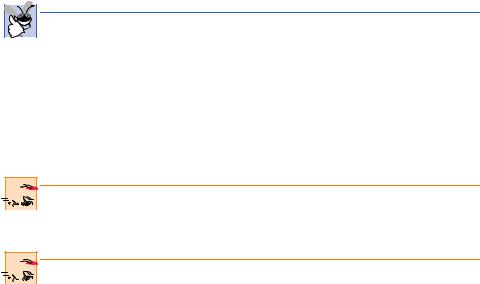
210 |
Control Structures: Part 2 |
Chapter 5 |
|
Notice that the variables amount, principal and rate are of type double. We |
|
did this for simplicity, because we are dealing with fractional parts of dollars and thus need a type that allows decimal points in its values. Unfortunately, this setting can cause trouble. Here is a simple explanation of what can go wrong when using float or double to represent dollar amounts (assuming that dollar amounts are displayed with two digits to the right of the decimal point): Two double dollar amounts stored in the machine could be 14.234 (which would normally be rounded to 14.23 for display purposes) and 18.673 (which would normally be rounded to 18.67 for display purposes). When these amounts are added, they produce the internal sum 32.907, which would normally be rounded to 32.91 for display purposes. Thus, your printout could appear as
14.23 + 18.67
-------
32.91
but a person adding the individual numbers as printed would expect the sum to be 32.90. You have been warned!
 Good Programming Practice 5.10
Good Programming Practice 5.10
Do not use variables of type float or double to perform precise monetary calculations.  The imprecision of floating-point numbers can cause errors that will result in incorrect monetary values. In the exercises, we explore the use of integers to perform monetary calculations. [Note: Some third-party vendors provide for-sale class libraries that perform precise monetary calculations.]
The imprecision of floating-point numbers can cause errors that will result in incorrect monetary values. In the exercises, we explore the use of integers to perform monetary calculations. [Note: Some third-party vendors provide for-sale class libraries that perform precise monetary calculations.]
Note that the body of the for structure contains the calculation 1.0 + rate, which appears as an argument to the Math.pow method. In fact, this calculation produces the same result each time through the loop, so repeating the calculation every iteration of the loop is wasteful.
Performance Tip 5.1

 Avoid placing expressions whose values do not change inside loops. But even if you do, many
Avoid placing expressions whose values do not change inside loops. But even if you do, many  of today’s sophisticated optimizing compilers will place such expressions outside loops in the generated compiled code.
of today’s sophisticated optimizing compilers will place such expressions outside loops in the generated compiled code.
Performance Tip 5.2

 Many compilers contain optimization features that improve the code that you write, but it is
Many compilers contain optimization features that improve the code that you write, but it is  still better to write good code from the start.
still better to write good code from the start.
5.5 The switch Multiple-Selection Structure
We have discussed the if single-selection structure and the if/else double-selection structure. Occasionally, an algorithm contains a series of decisions in which the algorithm tests a variable or expression separately for each of the constant integral values (i.e., values of types byte, short, int and char) the variable or expression may assume and takes different actions based on those values. Java provides the switch multiple-selection structure to handle such decision making. The applet of Fig. 5.7 demonstrates drawing lines, rectangles or ovals, based on an integer the user inputs via an input dialog.
© Copyright 1992–2002 by Deitel & Associates, Inc. All Rights Reserved. 7/2/01
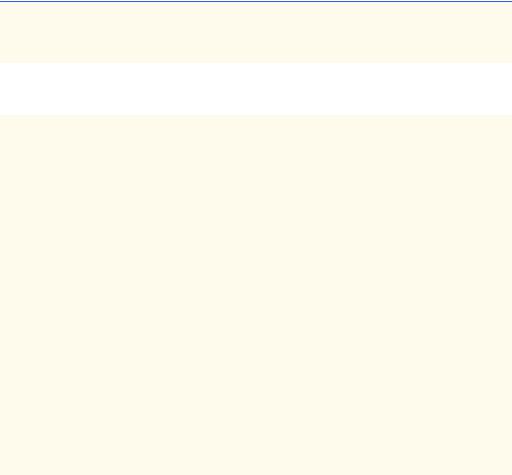
Chapter 5 |
Control Structures: Part 2 |
211 |
1// Fig. 5.7: SwitchTest.java
2 // Drawing lines, rectangles or ovals based on user input.
3
4// Java core packages
5 |
import java.awt.Graphics; |
|
6 |
|
|
7 |
// Java extension packages |
|
8 |
import javax.swing.*; |
|
9 |
|
|
10 |
public class SwitchTest extends JApplet { |
|
11 |
int choice; |
// user's choice of which shape to draw |
12 |
|
|
13// initialize applet by obtaining user's choice
14public void init()
15{
16String input; // user's input
17
18// obtain user’s choice
19input = JOptionPane.showInputDialog(
20 |
"Enter 1 |
to draw lines\n" + |
|
21 |
"Enter |
2 |
to draw rectangles\n" + |
22 |
"Enter |
3 |
to draw ovals\n" ); |
23 |
|
|
|
24// convert user's input to an int
25choice = Integer.parseInt( input );
26}
27
28// draw shapes on applet's background
29public void paint( Graphics g )
30{
31// call inherited version of method paint
32super.paint( g );
33
34// loop 10 times, counting from 0 through 9
35for ( int i = 0; i < 10; i++ ) {
36 |
|
|
|
|
37 |
// determine shape to draw based on user's choice |
|||
38 |
switch ( choice ) { |
|
||
39 |
|
|
|
|
40 |
case 1: |
|
|
|
41 |
g.drawLine( |
10, |
10, 250, 10 + i * 10 ); |
|
42 |
break; |
// done |
processing case |
|
43 |
|
|
|
|
44 |
case 2: |
|
|
|
45 |
g.drawRect( |
10 + i * 10, 10 + i * 10, |
||
46 |
50 + i * |
10, |
50 + i * 10 ); |
|
47 |
break; |
// done |
processing case |
|
48 |
|
|
|
|
49 |
case 3: |
|
|
|
50 |
g.drawOval( |
10 + i * 10, 10 + i * 10, |
||
51 |
50 + i * |
10, |
50 + i * 10 ); |
|
52 |
break; |
// done |
processing case |
|
53 |
|
|
|
|
|
|
|
||
Fig. 5.7 |
An example using switch (part |
1 of 3). |
||
© Copyright 1992–2002 by Deitel & Associates, Inc. All Rights Reserved. 7/2/01
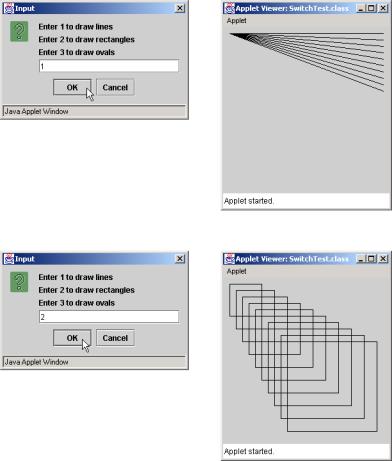
212 |
|
Control Structures: Part 2 |
Chapter 5 |
|
|
|
|
54 |
|
default: |
|
55 |
|
g.drawString( "Invalid value entered", |
|
56 |
|
10, 20 + i * 15 ); |
|
57 |
|
|
|
58 |
|
} // end switch structure |
|
59 |
|
|
|
60 |
|
} // end for structure |
|
61 |
|
|
|
62 |
|
} // end paint method |
|
63 |
|
|
|
64 |
} |
// end class SwitchTest |
|
|
|
|
|
Fig. 5.7 An example using switch (part 2 of 3).
© Copyright 1992–2002 by Deitel & Associates, Inc. All Rights Reserved. 7/2/01
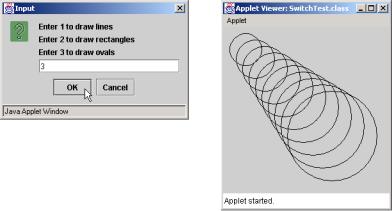
Chapter 5 |
Control Structures: Part 2 |
213 |
|
|
|
|
|
|
Fig. 5.7 An example using switch (part 3 of 3).
Line 11 in applet SwitchTest defines instance variable choice of type int. This variable stores the user’s input that determines which type of shape to draw in paint.
Method init (lines 14–26) declares local variable input of type String in line 16. This variable stores the String the user types in the input dialog. Lines 19–22 display the input dialog with static method JOptionPane.showInputDialog and prompt the user to enter 1 to draw lines, 2 to draw rectangles or 3 to draw ovals. Line 25 converts input from a String to an int and assigns the result to choice.
Method paint (lines 29–62) contains a for structure (lines 35–60) that loops 10 times. In this example, the for structure’s header, in line 35, uses zero-based counting. The values of i for the 10 iterations of the loop are 0, 1, 2, 3, 4, 5, 6, 7, 8 and 9, and the loop terminates when i’s value becomes 10. [Note: As you know, the applet container calls method paint after methods init and start. The applet container also calls method paint whenever the applet’s screen area must be refreshed—e.g., after another window that covered the applet’s area is moved to a different location on the screen.]
Nested in the for structure’s body is a switch structure (lines 38–58) that draws shapes based on the integer value input by the user in method init. The switch structure consists of a series of case labels and an optional default case.
When the flow of control reaches the switch structure, the program evaluates the controlling expression (choice) in the parentheses following keyword switch. The program compares the value of the controlling expression (which must evaluate to an integral value of type byte, char, short or int) with each case label. Assume that the user entered the integer 2 as his or her choice. The program compares 2 with each case in the switch. If a match occurs (case 2:), the program executes the statements for that case. For the integer 2, lines 44–47 draw a rectangle, using four arguments, representing the upper left x-coordinate, upper left y-coordinate, width and height of the rectangle, and the switch structure exits immediately with the break statement. Then, the program increments the counter variable in the for structure and reevaluates the loop-continuation condition to determine whether to perform another iteration of the loop.
The break statement causes program control to proceed with the first statement after the switch structure. (In this case, we reach the end of the for structure’s body, so con-
© Copyright 1992–2002 by Deitel & Associates, Inc. All Rights Reserved. 7/2/01
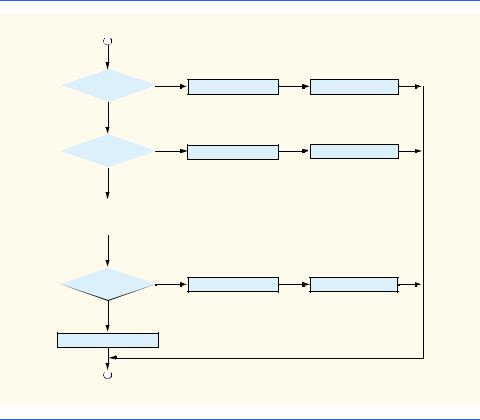
214 |
Control Structures: Part 2 |
Chapter 5 |
trol flows to the control variable’s increment expression in the header of the for structure.) Without break, the cases in a switch statement would run together. Each time a match occurs in the structure, the statements for all the remaining cases will execute. (This feature is perfect for programming the iterative song “The Twelve Days of Christmas.”) If no match occurs between the controlling expression’s value and a case label, the default case executes, and the program draws an error message on the applet.
Each case can have multiple actions. The switch structure differs from other structures in that it does not require braces around multiple actions in each case. Figure 5.8 shows the general switch structure flowchart (using a break in each case). [Note: As an exercise, make a flowchart of the general switch structure without breaks.]
The flowchart makes it clear that each break statement at the end of a case causes control to exit the switch structure immediately. The break statement is not required for the last case in the switch structure (or the default case, when it appears last), because the program continues with the next statement after the switch.
Again, note that, besides small circles and arrows, the flowchart contains only rectangle and diamond symbols. It is the programmer’s responsibility to fill the rectangles and diamonds with actions and decisions appropriate to the algorithm. Although nested control structures are common, it is rare to find nested switch structures in a program.
case a |
true |
case a action(s) |
break |
|
|||
false |
|
|
|
case b |
true |
case b action(s) |
break |
|
|||
false |
|
|
|
. |
|
|
|
. |
|
|
|
. |
|
|
|
case z |
true |
case z action(s) |
break |
|
|||
false |
|
|
|
default action(s) |
|
|
|
Fig. 5.8 The switch multiple-selection structure.
© Copyright 1992–2002 by Deitel & Associates, Inc. All Rights Reserved. 7/2/01
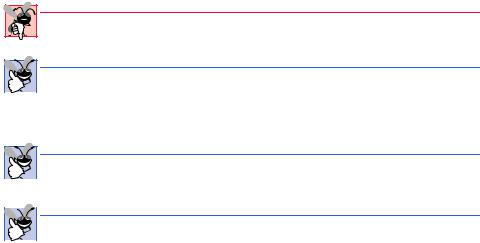
Chapter 5 |
Control Structures: Part 2 |
215 |
Common Programming Error 5.7
Forgetting a break statement when one is needed in a switch structure is a logic error.
Good Programming Practice 5.11
Provide a default case in switch statements. Cases not explicitly tested in a switch  statement without a default case are ignored. Including a default case focuses the programmer on the need to process exceptional conditions. There are situations in which no default processing is needed.
statement without a default case are ignored. Including a default case focuses the programmer on the need to process exceptional conditions. There are situations in which no default processing is needed.
Good Programming Practice 5.12
Although the cases and the default case in a switch structure can occur in any order,  it is considered a good programming practice to place the default clause last.
it is considered a good programming practice to place the default clause last.
 Good Programming Practice 5.13
Good Programming Practice 5.13
In a switch structure, when the default clause is listed last, the break for that case  statement is not required. Some programmers include this break for clarity and symmetry with other cases.
statement is not required. Some programmers include this break for clarity and symmetry with other cases.
Note that listing case labels together (such as case 1: case 2: with no statements between the cases) performs the same set of actions for each case.
When using the switch structure, remember that the expression after each case can be only a constant integral expression (i.e., any combination of character constants and integer constants that evaluates to a constant integer value). A character constant is represented as the specific character in single quotes, such as 'A'. An integer constant is simply an integer value. The expression after each case also can be a constant variable—i.e., a variable that contains a value which does not change for the entire program. Such a variable is declared with keyword final (discussed in Chapter 6). When we discuss object-ori- ented programming in Chapter 9, we present a more elegant way to implement switch logic. We use a technique called polymorphism to create programs that are often clearer, easier to maintain and easier to extend than programs using switch logic.
5.6 The do/while Repetition Structure
The do/while repetition structure is similar to the while structure. In the while structure, the program tests the loop-continuation condition at the beginning of the loop, before performing the body of the loop. The do/while structure tests the loop-continuation condition after performing the body of the loop; therefore, the loop body always executes at least once. When a do/while structure terminates, execution continues with the statement after the while clause. Note that it is not necessary to use braces in the do/while structure if there is only one statement in the body. However, most programmers include the braces, to avoid confusion between the while and do/while structures. For example,
while ( condition )
normally is the first line of a while structure. A do/while structure with no braces around a single-statement body appears as
do
statement
while ( condition );
© Copyright 1992–2002 by Deitel & Associates, Inc. All Rights Reserved. 7/2/01

216 |
Control Structures: Part 2 |
Chapter 5 |
which can be confusing. Reader may misinterpret the last line—while( condition );— as a while structure containing an empty statement (the semicolon by itself). Thus, to avoid confusion, the do/while structure with one statement often is written as follows:
do { statement
} while ( condition );
 Good Programming Practice 5.14
Good Programming Practice 5.14
Some programmers always include braces in a do/while structure, even if the braces are  not necessary. This helps eliminate ambiguity between the while structure and the do/ while structure containing only one statement.
not necessary. This helps eliminate ambiguity between the while structure and the do/ while structure containing only one statement.
Common Programming Error 5.8

 Infinite loops occur when the loop-continuation condition in a while, for or do/while
Infinite loops occur when the loop-continuation condition in a while, for or do/while  structure never becomes false. To prevent this situation, make sure that there is not a semicolon immediately after the header of a while or for structure. In a counter-controlled loop, ensure that the control variable is incremented (or decremented) in the body of the loop. In a sentinel-controlled loop, ensure that the sentinel value is eventually input.
structure never becomes false. To prevent this situation, make sure that there is not a semicolon immediately after the header of a while or for structure. In a counter-controlled loop, ensure that the control variable is incremented (or decremented) in the body of the loop. In a sentinel-controlled loop, ensure that the sentinel value is eventually input.
The applet in Fig. 5.9 uses a do/while structure to draw 10 nested circles, using
Graphics method drawOval.
1// Fig. 5.9: DoWhileTest.java
2 // Using the do/while repetition structure.
3
4// Java core packages
5 import java.awt.Graphics;
6
7 // Java extension packages
8 import javax.swing.JApplet;
9
10 public class DoWhileTest extends JApplet {
11
12// draw lines on applet’s background
13public void paint( Graphics g )
14{
15// call inherited version of method paint
16super.paint( g );
17 |
|
18 |
int counter = 1; |
19 |
|
20 |
do { |
21 |
g.drawOval( 110 - counter * 10, 110 - counter * 10, |
22 |
counter * 20, counter * 20 ); |
23++counter;
24} while ( counter <= 10 ); // end do/while structure
26 } // end method paint
27
28 } // end class DoWhileTest
Fig. 5.9 Using the do/while repetition structure (part 1 of 2).
© Copyright 1992–2002 by Deitel & Associates, Inc. All Rights Reserved. 7/2/01
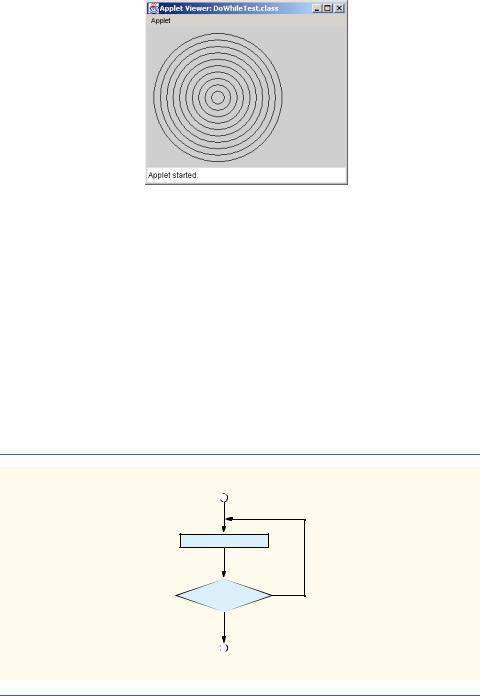
Chapter 5 |
Control Structures: Part 2 |
217 |
|
|
|
|
|
|
Fig. 5.9 Using the do/while repetition structure (part 2 of 2).
In method paint (lines 13–26), line 18 declares control variable counter and initializes it to 1. Upon entering the do/while structure, lines 21–22 send the drawOval message to the Graphics object to which g refers. The four arguments that represent the upper left x-coordinate, upper left y-coordinate, width and height of the oval’s bounding box (an imaginary rectangle in which the oval touches the center of all four sides of the rectangle) are calculated based on the value of counter. The program draws the innermost oval first. The bounding box’s upper left corner for each subsequent oval moves closer to the upper left corner of the applet. At the same time, the width and height of the bounding box are increased, to ensure that each new oval contains all the previous ovals. Line 23 increments counter. Then, the program evaluates the loop-continuation test at the bottom of the loop. The do/while flowchart in Fig. 5.10 makes it clear that the program does not evaluate the loop-continuation condition until after the action executes once.
action(s)
true
condition
false
Fig. 5.10 Flowcharting the do/while repetition structure.
© Copyright 1992–2002 by Deitel & Associates, Inc. All Rights Reserved. 7/2/01
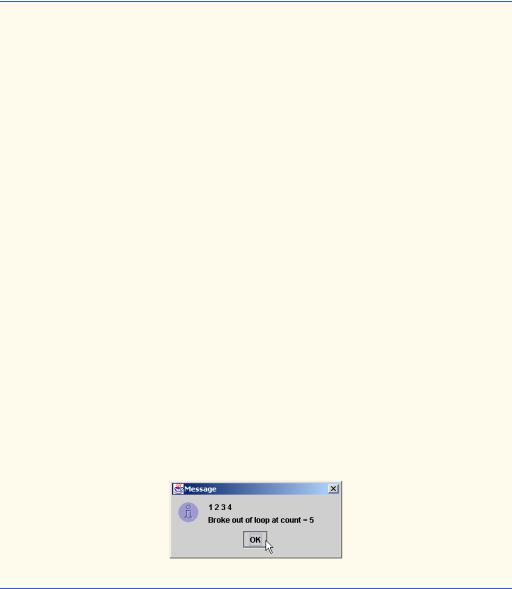
218 |
Control Structures: Part 2 |
Chapter 5 |
5.7 Statements break and continue
The break and continue statements alter the flow of control. The break statement, when executed in a while, for, do/while or switch structure, causes immediate exit from that structure. Execution continues with the first statement after the structure. Common uses of the break statement are to escape early from a loop or skip the remainder of a switch structure (as in Fig. 5.7). Figure 5.11 demonstrates the break statement in a for repetition structure.
1// Fig. 5.11: BreakTest.java
2 // Using the break statement in a for structure
3
4// Java extension packages
5 import javax.swing.JOptionPane;
6
7 public class BreakTest {
8
9 // main method begins execution of Java application
10public static void main( String args[] )
11{
12String output = "";
13int count;
14
15// loop 10 times
16for ( count = 1; count <= 10; count++ ) {
18 |
// if count is 5, terminate loop |
19 |
if ( count == 5 ) |
20 |
break; // break loop only if count == 5 |
21 |
|
22 |
output += count + " "; |
23 |
|
24 |
} // end for structure |
25 |
|
26output += "\nBroke out of loop at count = " + count;
27JOptionPane.showMessageDialog( null, output );
28
29 System.exit( 0 ); // terminate application
30
31 } // end method main
32
33 } // end class BreakTest
Fig. 5.11 Using the break statement in a for structure.
© Copyright 1992–2002 by Deitel & Associates, Inc. All Rights Reserved. 7/2/01

Chapter 5 |
Control Structures: Part 2 |
219 |
When the if structure at line 19 in the for structure detects that count is 5, the break statement at line 20 executes. This statement terminates the for structure, and the program proceeds to line 26 (immediately after the for). Line 26 completes the string to display in a message dialog at line 27. The loop fully executes its body only four times.
The continue statement, when executed in a while, for or do/while structure, skips the remaining statements in the loop body and proceeds with the next iteration of the loop. In while and do/while structures, the program evaluates the loop-continuation test immediately after the continue statement executes. In for structures, the increment expression executes, then the program evaluates the loop-continuation test. Earlier, we stated that the while structure could be used in most cases to represent the for structure. The one exception occurs when the increment expression in the while structure follows the continue statement. In this case, the increment does not execute before the program evaluates the repetition-continuation condition, so the while structure does not execute in the same manner as does the for structure. Figure 5.12 uses the continue statement in a for structure to skip the string concatenation statement (line 22) when the if structure (line 18) determines that the value of count is 5. When the continue statement executes, program control continues with the increment of the control variable in the for structure.
 Good Programming Practice 5.15
Good Programming Practice 5.15
Some programmers feel that break and continue violate structured programming. Be-  cause the effects of these statements are achievable with structured programming techniques, these programmers do not use break and continue.
cause the effects of these statements are achievable with structured programming techniques, these programmers do not use break and continue.
1// Fig. 5.12: ContinueTest.java
2 // Using the continue statement in a for structure
3
4// Java extension packages
5 import javax.swing.JOptionPane;
6
7 public class ContinueTest {
8
9 // main method begins execution of Java application
10public static void main( String args[] )
11{
12String output = "";
13
14// loop 10 times
15for ( int count = 1; count <= 10; count++ ) {
17 |
// if count is 5, continue with next iteration of loop |
|
18 |
if ( count == |
5 ) |
19 |
continue; |
// skip remaining code in loop |
20 |
|
// only if count == 5 |
21 |
|
|
22 |
output += count + " "; |
|
23 |
|
|
24 |
} // end for structure |
|
25 |
|
|
Fig. 5.12 Using the continue statement in a for structure (part 1 of 2).
© Copyright 1992–2002 by Deitel & Associates, Inc. All Rights Reserved. 7/2/01
